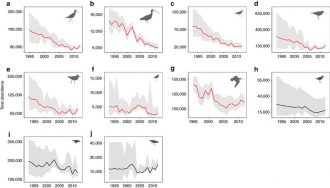New study highlights vital importance of Yellow Sea
Based on decades of bird counting effort by volunteers across Australia and New Zealand, Dr Studds from University of Maryland (Blatimore, US) and their co-authors have assessed population trends of ten shorebird taxa that refuel on Yellow Sea tidal mudflats. After accounting for the shared evolutionary history among taxa, migration distance, breeding range size, non-breeding location, generation time and body size, they found that Yellow Sea reliance was the single most important predictor of variation in population trends. In other words, more a species relies on the the disappearing Yellow Sea mudflats, the faster they are declining!
“Scientists have long believed that loss of these rest stops could be related to the declines, but there was no smoking gun,” Dr Studds said.
Full article published in Nature Communications:
Interview of the authors: https://birdlife.org.au/media/loss-of-key-shorebird-refuelling-areas/

Total abundance between 1993 and 2012 for ten EAAF migratory shorebird taxa. ©Nature communication.
Featured image: Far Eastern Curlew are among studied shorebird species with the hightest Yellow Sea reliance. Far Eastern Curlew Numenius madagascariensis. ©Kenji Nishikawa, September 2010.
